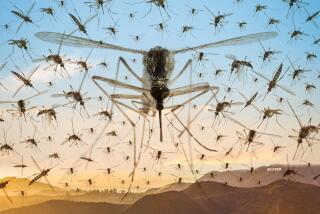The average home has more than 100 kinds of bugs living in it, new study finds
- Share via
Don’t panic, but your house probably has a lot more bugs in it than you think.
The average home contains more than 100 different species of flies, spiders, beetles, ants and other bugs — with an even greater variety inside houses in wealthier neighborhoods, according to a new study in Biology Letters.
The paper highlights an unexpected diversity of life found in our own indoor habitats, suggesting the “wild” isn’t as far from home as we thought.
Before you reach for the fly swatter or can of Raid, know this: Most of the bugs in our dwellings are not destructive or disease-carrying critters such as termites, ticks and cockroaches. Instead of pests, the survey found mostly benign species that are often so small that people rarely notice them.
See the most-read stories in Science this hour »
The arthropods among us have “been there before you read this article and they didn’t bother you then, so knowing they’re there now shouldn’t really change that,” said Misha Leong, an entomologist at the California Academy of Sciences and the study’s lead author. “They’ll just continue being your quiet, respectable roommates.”
To get an idea of the kinds of bugs that co-habitate with humans, entomologists at North Carolina State University and the North Carolina Museum of Natural Sciences surveyed the homes of 50 volunteers in the Raleigh area.
Donning headlamps and kneepads and armed with forceps, nets and vacuum-like bug collecting devices called aspirators, the researchers scoured nearly every room of each house. They collected all varieties of living and dead arthropods — the group that includes flies, spiders, beetles, ants and crustaceans — hidden inside.
In total, the bug census included 10,000 specimens, which took scientists two years to categorize. The results of their initial survey were published in PeerJ in January.
“It appears that the vast majority of arthropods that live among us cause no direct harm,” the authors of the study, led by NCSU entomologist Matt Bertone, wrote in PeerJ. “Unfortunately, many insects and arthropods we collected are considered pests based solely on their presence in the home.”
Houses are like giant traps for tiny crawling and flying critters.
While some species rely on built environments, most simply wind up indoors by accident after following an attractive light or looking for something to eat. The results are often tragic — for the bug.
And while humans often try to keep their homes free of insects and spiders, our dwellings are not as insulated from the outdoors as some might hope.
The new study suggests a neighborhood’s affluence may be a better predictor of indoor bug diversity than, say, a home’s cleanliness.
It all starts with the plants in the backyard.
In general, people with more money plant more extensive gardens, which studies have shown can attract a greater variety of birds, lizards and bats.
This so-called “luxury effect”— the idea that socioeconomic factors influence local biodiversity — also extends to bugs.
Even properties without many plants still had a high number of bug species inside if they were in a rich neighborhood, where they were more likely to be near lush parks and neighbors with big gardens. Property lines, of course, don’t matter to bugs.
“It matters, in short, not only how much vegetation you have in your yard, but how much is present in the yards and other habitats nearby,” the study authors wrote.
The researchers have plans to expand their census of indoor bug life beyond the fairly limited North Carolina sample.
In Raleigh, the homes surveyed were all free-standing structures in middle- and higher-income neighborhoods. Now the work must expand to a wider range of neighborhoods and housing types, the authors wrote.
Leong and colleagues have already sampled houses in the Peruvian Amazon, Sweden and San Francisco, including homes belonging to Cal Academy of Sciences employees. Through 2017, the next stops are in Australia, Madagascar, China and, hopefully, research field stations in Antarctica.
This type of survey could help scientists begin to understand how urbanization and human-altered landscapes shape ecology and biodiversity.
For example, if the scientists were to look at houses with insect infestations, what would they find?
Perhaps infestations occur because homes are lacking in arthropod diversity. If cockroaches or termites take over a place, maybe it’s because there wasn’t enough of another bug to stop them, Leong said.
“That’s something we don’t know, but it’s an ecological concept that biodiversity usually prevents infestations,” she said. “I think it’d be cool to see if that applies indoors.”
A future study will try to find out which species truly live as our roommates and which are the vagabond species that simply come for a visit. If a species is found in at least 50% of the rooms in the house, it may be more likely to be reproducing and thriving indoors, Leong said.
Ultimately, the entomologists want to know whether the rules of ecology are the same in the built environment as they are in the wild, she said.
“We can’t just write off man-made or human-altered environments as being completely artificial, because there are a lot of ecological dynamics at play,” Leong said.
Follow me on Twitter @seangreene89 and “like” Los Angeles Times Science on Facebook.
MORE IN SCIENCE
Scientists tally benefits of replacing thirsty lawns with drought-tolerant plants
Unfortunate dinosaur in New Jersey suffered from horrific case of arthritis
Watch sunflowers dance under the sun (Seriously)







